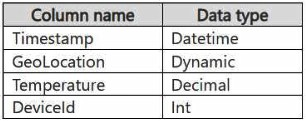At ValidExamDumps, we consistently monitor updates to the Microsoft DP-700 exam questions by Microsoft. Whenever our team identifies changes in the exam questions,exam objectives, exam focus areas or in exam requirements, We immediately update our exam questions for both PDF and online practice exams. This commitment ensures our customers always have access to the most current and accurate questions. By preparing with these actual questions, our customers can successfully pass the Microsoft Implementing Data Engineering Solutions Using Microsoft Fabric exam on their first attempt without needing additional materials or study guides.
Other certification materials providers often include outdated or removed questions by Microsoft in their Microsoft DP-700 exam. These outdated questions lead to customers failing their Microsoft Implementing Data Engineering Solutions Using Microsoft Fabric exam. In contrast, we ensure our questions bank includes only precise and up-to-date questions, guaranteeing their presence in your actual exam. Our main priority is your success in the Microsoft DP-700 exam, not profiting from selling obsolete exam questions in PDF or Online Practice Test.
Note: This question is part of a series of questions that present the same scenario. Each question in the series contains a unique solution that might meet the stated goals. Some question sets might have more than one correct solution, while others might not have a correct solution.
After you answer a question in this section, you will NOT be able to return to it. As a result, these questions will not appear in the review screen.
You have a Fabric eventstream that loads data into a table named Bike_Location in a KQL database. The table contains the following columns:
BikepointID
Street
Neighbourhood
No_Bikes
No_Empty_Docks
Timestamp
You need to apply transformation and filter logic to prepare the data for consumption. The solution must return data for a neighbourhood named Sands End when No_Bikes is at least 15. The results must be ordered by No_Bikes in ascending order.
Solution: You use the following code segment:

Does this meet the goal?
This code does not meet the goal because it uses sort by without specifying the order, which defaults to ascending, but explicitly mentioning asc improves clarity.
Correct code should look like:

You have five Fabric workspaces.
You are monitoring the execution of items by using Monitoring hub.
You need to identify in which workspace a specific item runs.
Which column should you view in Monitoring hub?
To identify in which workspace a specific item runs in Monitoring hub, you should view the Location column. This column indicates the workspace where the item is executed. Since you have multiple workspaces and need to track the execution of items across them, the Location column will show you the exact workspace associated with each item or job execution.
You are implementing a medallion architecture in a Fabric lakehouse.
You plan to create a dimension table that will contain the following columns:
* ID
* CustomerCode
* CustomerName
* CustomerAddress
* CustomerLocation
* ValidFrom
* ValidTo
You need to ensure that the table supports the analysis of historical sales data by customer location at the time of each sale Which type of slowly changing dimension (SCD) should you use?
You have a Fabric warehouse named DW1. DW1 contains a table that stores sales data and is used by multiple sales representatives.
You plan to implement row-level security (RLS).
You need to ensure that the sales representatives can see only their respective data.
Which warehouse object do you require to implement RLS?
To implement Row-Level Security (RLS) in a Fabric warehouse, you need to use a function that defines the security logic for filtering the rows of data based on the user's identity or role. This function can be used in conjunction with a security policy to control access to specific rows in a table.
In the case of sales representatives, the function would define the filtering criteria (e.g., based on a column such as SalesRepID or SalesRepName), ensuring that each representative can only see their respective data.
Note: This question is part of a series of questions that present the same scenario. Each question in the series contains a unique solution that might meet the stated goals. Some question sets might have more than one correct solution, while others might not have a correct solution.
After you answer a question in this section, you will NOT be able to return to it. As a result, these questions will not appear in the review screen.
You have a KQL database that contains two tables named Stream and Reference. Stream contains streaming data in the following format.

Reference contains reference data in the following format.

Both tables contain millions of rows.
You have the following KQL queryset.

You need to reduce how long it takes to run the KQL queryset.
Solution: You add the make_list() function to the output columns.
Does this meet the goal?
Adding an aggregation like make_list() would require additional processing and memory, which could make the query slower.